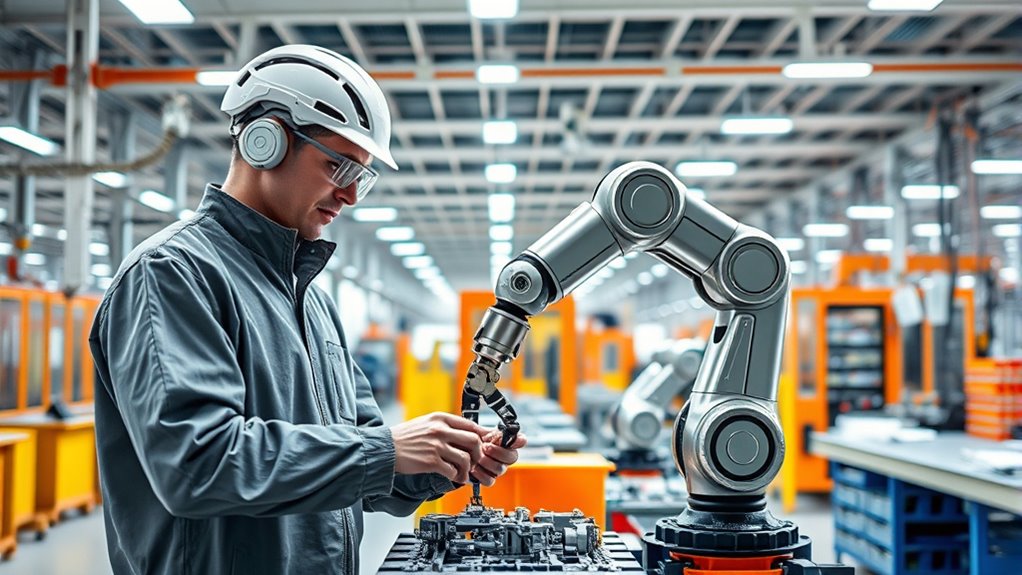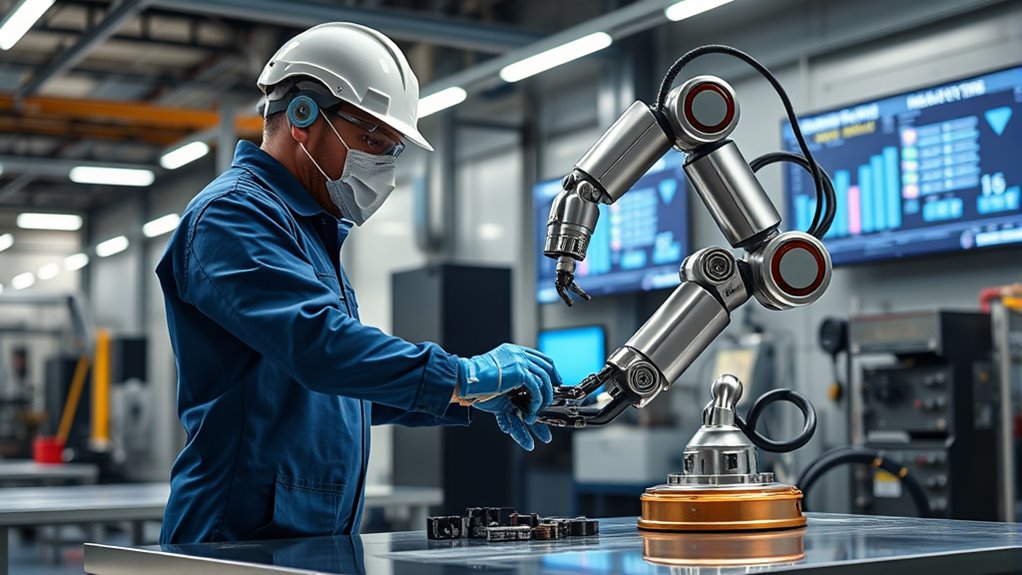Cross-training with cobots helps you develop new skills, build trust, and improve teamwork. It guarantees you can work seamlessly alongside these robots, taking on repetitive or hazardous tasks while focusing on creative problem-solving. This continuous learning makes you more adaptable and responsive in dynamic environments. As you enhance your skills, you’ll increase job satisfaction and confidence. To discover how to maximize these benefits, keep exploring ways to upgrade your human-robot collaboration skills.
Key Takeaways
- Cross-training with cobots fosters seamless collaboration and mutual trust between humans and robots.
- It enhances team flexibility and adaptability to evolving technologies and changing environments.
- Workers develop new skills, increasing their value and confidence in working alongside cobots.
- Continuous learning improves job satisfaction and promotes a positive, engaging work atmosphere.
- Educational initiatives using cobots prepare students for future workplaces with human-robot collaboration.

Have you ever wondered how humans and cobots can work together more effectively? Cross-training is the key to access a seamless partnership between people and robots. When you invest in cross-training programs, you foster better collaboration by helping everyone understand each other’s strengths and limitations. This mutual understanding builds trust, which is essential for a productive and safe working environment. By tailoring training to specific tasks, teams become more efficient. You learn how to leverage cobots for repetitive or hazardous tasks while focusing your skills on more complex, strategic work. This targeted approach guarantees both humans and cobots operate at their full potential, leading to smoother workflows.
Cross-training fosters trust and efficiency between humans and cobots for safer, more productive collaboration.
Continuous learning plays a fundamental role in keeping your team current with the latest technologies and best practices. As technology evolves, so should your skills. This ongoing education boosts overall performance and helps prevent stagnation. Cross-training also makes your team more flexible and adaptable. When tasks or environments change, you can pivot quickly, minimizing downtime and maintaining productivity. In a dynamic workspace, this agility is indispensable. You and your colleagues develop a broader skill set, making each person more versatile and capable of tackling different responsibilities. This increased flexibility benefits everyone, especially in fast-paced or unpredictable settings.
For human workers, cross-training offers numerous benefits. You develop new skills, making you more valuable within your team. As you gain confidence in working alongside cobots, trust naturally builds. This trust enhances collaboration, allowing you to rely on cobots to handle routine or dangerous tasks, reducing fatigue and physical strain. With cobots taking over repetitive chores, you can focus on creative problem-solving and innovation. This shift not only improves your job satisfaction but also sparks greater engagement. When you see how cobots support your work, it fosters a positive environment where you’re motivated to learn and grow. Incorporating juice cleansing principles into work routines can also promote better hydration and energy levels, enhancing overall productivity.
In educational settings, cobots make technical learning more interactive and accessible. They encourage teamwork among students and inspire innovation through immediate feedback and experimentation. As a result, students develop essential STEM skills and increased interest in science and technology fields. This hands-on experience lowers barriers to entry, making advanced skills more attainable for a wider range of learners. The integration of cobots in education not only enhances technical knowledge but also prepares students for future workplaces where human-robot collaboration is standard.
Frequently Asked Questions
How Does Cross-Training Impact Overall Team Productivity?
You see, cross-training boosts overall team productivity by making everyone more adaptable and skilled. When you learn multiple tasks, you can switch roles easily, reducing downtime. Better communication and collaboration also streamline workflows. As you develop technical and soft skills, your team works more efficiently, solves problems faster, and stays motivated. Ultimately, cross-training creates a more flexible, engaged team that consistently delivers higher performance and meets goals more effectively.
What Safety Protocols Are Necessary During Cobot Cross-Training?
You need to prioritize safety protocols during cobot cross-training to protect everyone. Start with clear signage and floor markings to guide safe movement. Guarantee emergency stops are accessible and lighting is sufficient for visibility. Provide thorough training on safe operation, hazard recognition, and emergency procedures. Regularly review safety protocols, perform audits, and involve your team in risk assessments. By staying vigilant, you keep the workspace safe and support effective learning.
How Can Companies Measure Success in Human-Cobot Collaboration?
You can measure success in human-cobot collaboration by tracking both quantitative and qualitative metrics. Monitor task completion times, error rates, and safety incidents to gauge productivity and safety. Gather worker feedback on trust, comfort, and workload to understand their experience. Observing interaction quality and engagement helps assess social dynamics. Combining these data points reveals how well humans and cobots work together, ensuring continuous improvement and safer, more efficient collaboration.
What Skills Are Most Valuable for Humans Working Alongside Cobots?
You’ll find that technical skills like programming, maintenance, and troubleshooting are essential when working with cobots. Equally important are communication, teamwork, and adaptability, which help you coordinate smoothly and respond to changing situations. Critical thinking and problem-solving ensure you can handle issues effectively, while safety awareness keeps everyone protected. Developing these skills enhances your ability to collaborate efficiently, making you a valuable asset in any human-cobot work environment.
Are There Industry-Specific Best Practices for Cross-Training With Cobots?
Think of industry-specific best practices as a tailored suit, fitting perfectly to your unique needs. You should conduct thorough needs assessments, choose cobots suited to your tasks, and involve safety experts to guarantee compliance. Regularly evaluate safety protocols, implement layered safety measures, and stay updated on standards like ISO 12100. By customizing training and safety procedures, you create a seamless, safe environment where humans and cobots work together harmoniously.
Conclusion
Now that you’ve seen how cobots can elevate your skills and expand your capabilities, imagine what’s next. Are you ready to access new opportunities and stay ahead in this evolving landscape? The real game-changer isn’t just the technology itself, but how you adapt and grow with it. Keep pushing boundaries—you might just discover a whole new level of mastery you never thought possible. The future of cross-training with cobots is waiting for you to take the leap.









